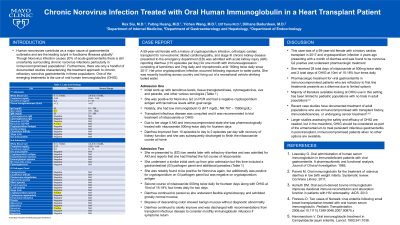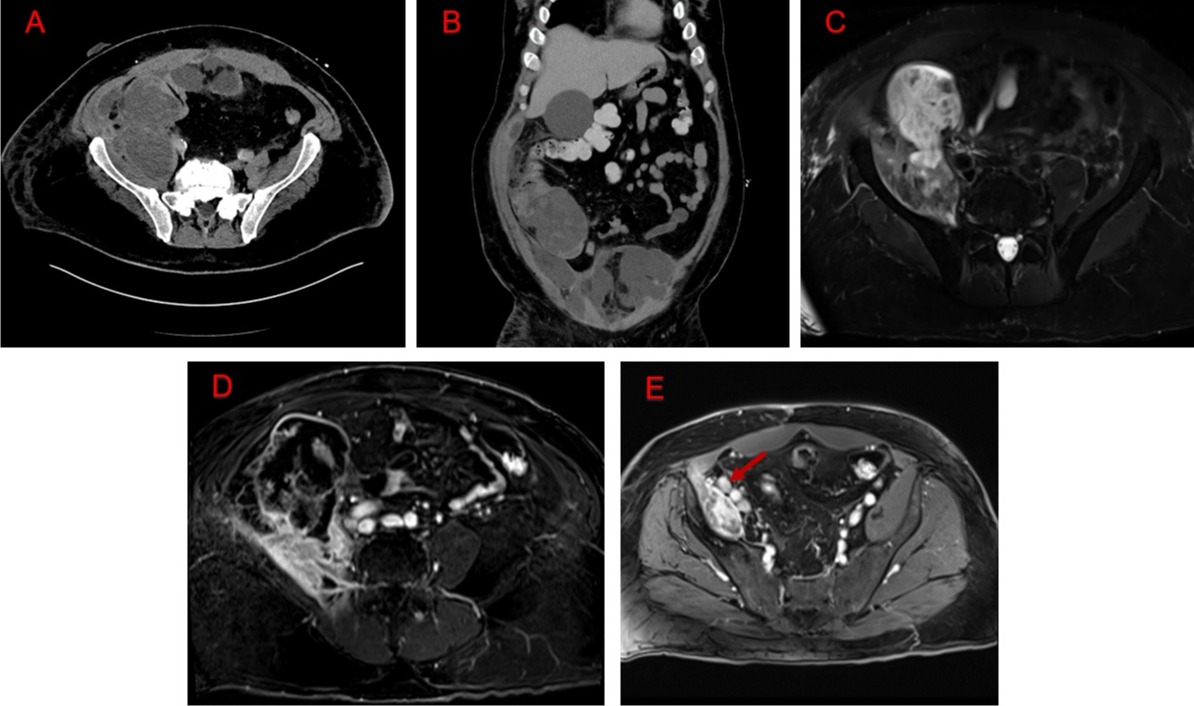Tuesday Poster Session
Category: IBD
P3661 - Colon Mass Masquerading as an Abscess
Tuesday, October 24, 2023
10:30 AM - 4:00 PM PT
Location: Exhibit Hall

Has Audio

Rex K. Siu, MD, MSc
Mayo Clinic School of Graduate Medical Education
Jacksonville, FL
Presenting Author(s)
Rex K. Siu, MD, MSc1, Yuting Huang, MBBS, PhD2, Anahita Tavana, MD1, Dilhana Badurdeen, MD2
1Mayo Clinic School of Graduate Medical Education, Jacksonville, FL; 2Mayo Clinic Florida, Jacksonville, FL
Introduction: MYH-associated polyposis (MAP) is an autosomal recessive disorder with a high risk of colorectal cancer. Current recommendations only covers endoscopic surveillance without recommendations for advanced imaging. This can be complicated in cases of MAP with Crohn’s overlap due to complications such as abscesses and fistulous disease.
Case Description/Methods: A 62-year-old man with a history of MAP and Montreal classification L3, B3, P Crohn’s disease (CD) in remission who presented with encephalopathy, slurred speech, and leukocytosis. MRI of the brain ruled out cerebral vascular accident and further infectious work-up was negative. CT abdomen/pelvis with intravenous contrast revealed a complex cystic mass measuring 13.7cm originating from the cecum and invading the right iliopsoas muscle (A), and anterolateral abdominal wall (B) with concern of tumor vs abscess. MRI abdomen/pelvis with IV gadolinium (C) demonstrated T2-hyperintense components and septated enhancement of the cecal mass with demonstration of enlarged right iliac node suggestive of mucinous malignancy. Of note, patient’s colonoscopy 12 months prior to the terminal ileum was negative for polyps or masses. Interventional radiology (IR) guided biopsies were initially deferred due to the lack of contrast enhancement between the colon mass and psoas muscle. Repeat, colonoscopy revealed a fungating, obstructive mass, suggestive of cancer, however, multiple biopsies were negative for malignancy. Due to the high suspicion for malignancy, IR guided biopsy was attempted and showed cells positive for CK20 and CDX2, negative for CK7 and TTF-1, consistent with tubular adenocarcinoma. He subsequently underwent a diverting loop ileostomy.
Discussion: This is a rare and unfortunate case where the coexistence of MAP and ileocolonic CD in remission developed into colonic mucinous adenocarcinoma despite routine endoscopic surveillance. Surveillance guidelines for MAP associated malignancy are a colonoscopy every 1-3 years starting at age of 18-20 years. However, there are no guidelines for surveillance in patients with genetic mutations and Crohn’s disease. This case underscores the potential utility and importance of incorporating advanced imaging techniques as part of surveillance for those with multiple risk factors for gastrointestinal malignancy.

Disclosures:
Rex K. Siu, MD, MSc1, Yuting Huang, MBBS, PhD2, Anahita Tavana, MD1, Dilhana Badurdeen, MD2. P3661 - Colon Mass Masquerading as an Abscess, ACG 2023 Annual Scientific Meeting Abstracts. Vancouver, BC, Canada: American College of Gastroenterology.
1Mayo Clinic School of Graduate Medical Education, Jacksonville, FL; 2Mayo Clinic Florida, Jacksonville, FL
Introduction: MYH-associated polyposis (MAP) is an autosomal recessive disorder with a high risk of colorectal cancer. Current recommendations only covers endoscopic surveillance without recommendations for advanced imaging. This can be complicated in cases of MAP with Crohn’s overlap due to complications such as abscesses and fistulous disease.
Case Description/Methods: A 62-year-old man with a history of MAP and Montreal classification L3, B3, P Crohn’s disease (CD) in remission who presented with encephalopathy, slurred speech, and leukocytosis. MRI of the brain ruled out cerebral vascular accident and further infectious work-up was negative. CT abdomen/pelvis with intravenous contrast revealed a complex cystic mass measuring 13.7cm originating from the cecum and invading the right iliopsoas muscle (A), and anterolateral abdominal wall (B) with concern of tumor vs abscess. MRI abdomen/pelvis with IV gadolinium (C) demonstrated T2-hyperintense components and septated enhancement of the cecal mass with demonstration of enlarged right iliac node suggestive of mucinous malignancy. Of note, patient’s colonoscopy 12 months prior to the terminal ileum was negative for polyps or masses. Interventional radiology (IR) guided biopsies were initially deferred due to the lack of contrast enhancement between the colon mass and psoas muscle. Repeat, colonoscopy revealed a fungating, obstructive mass, suggestive of cancer, however, multiple biopsies were negative for malignancy. Due to the high suspicion for malignancy, IR guided biopsy was attempted and showed cells positive for CK20 and CDX2, negative for CK7 and TTF-1, consistent with tubular adenocarcinoma. He subsequently underwent a diverting loop ileostomy.
Discussion: This is a rare and unfortunate case where the coexistence of MAP and ileocolonic CD in remission developed into colonic mucinous adenocarcinoma despite routine endoscopic surveillance. Surveillance guidelines for MAP associated malignancy are a colonoscopy every 1-3 years starting at age of 18-20 years. However, there are no guidelines for surveillance in patients with genetic mutations and Crohn’s disease. This case underscores the potential utility and importance of incorporating advanced imaging techniques as part of surveillance for those with multiple risk factors for gastrointestinal malignancy.

Figure: Axial and coronal reformatted CT images shown here demonstrate a complex cystic mass arising from the cecum and invading into the right iliopsoas muscle (A), as well as the anterior and right lateral abdominal wall (B). Axial T2-weighted, fat-saturated (C) and T1-weighted subtraction (D) sequences are shown here and demonstrate a cecal mass with T2-hyperintense component and septated enhancement with invasion into the right iliopsoas muscle. The axial T1-weighted, post-contrast (E) sequence also demonstrates an enlarged right external iliac node, measuring 1.8 x 1.1 cm (arrow).
Disclosures:
Rex Siu indicated no relevant financial relationships.
Yuting Huang indicated no relevant financial relationships.
Anahita Tavana indicated no relevant financial relationships.
Dilhana Badurdeen indicated no relevant financial relationships.
Rex K. Siu, MD, MSc1, Yuting Huang, MBBS, PhD2, Anahita Tavana, MD1, Dilhana Badurdeen, MD2. P3661 - Colon Mass Masquerading as an Abscess, ACG 2023 Annual Scientific Meeting Abstracts. Vancouver, BC, Canada: American College of Gastroenterology.
